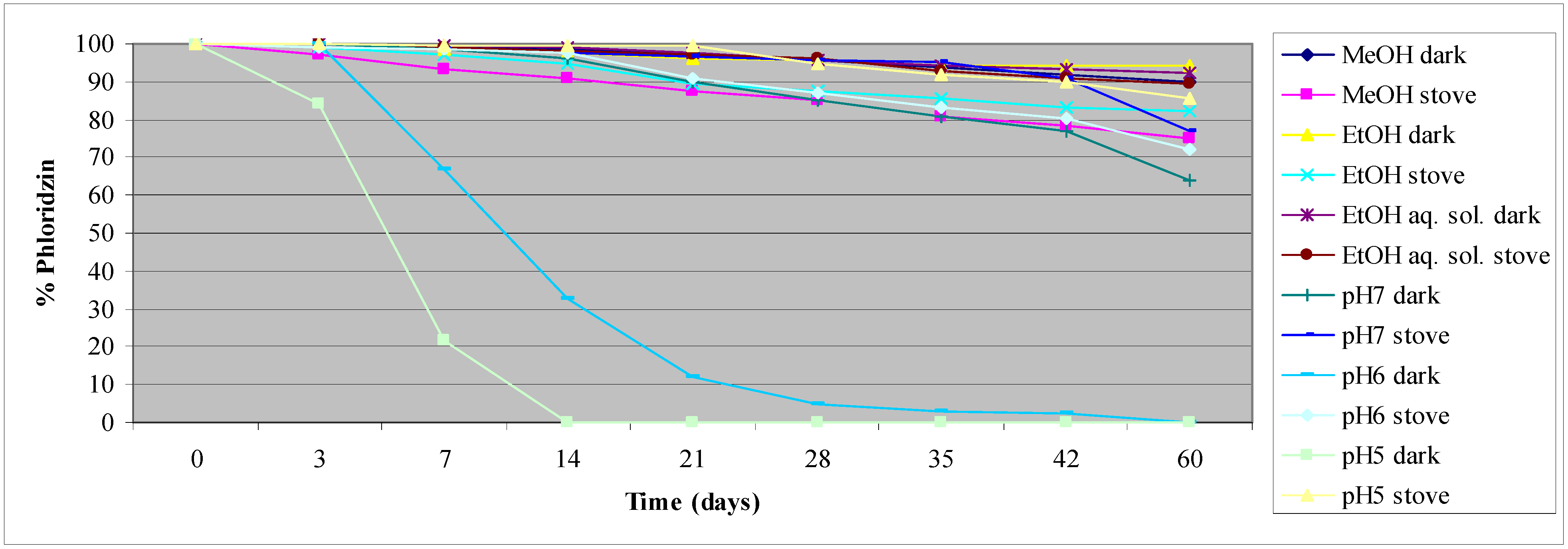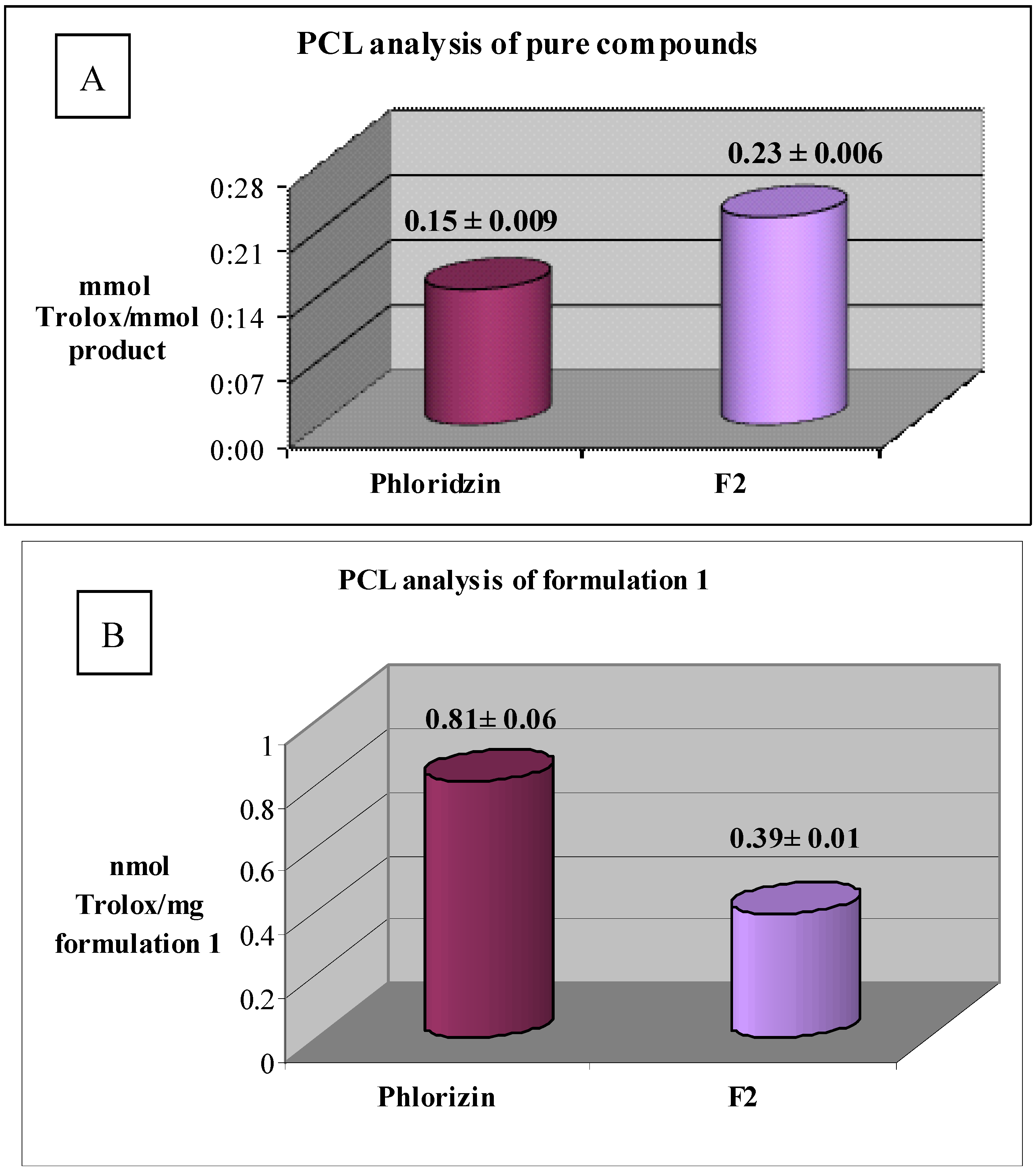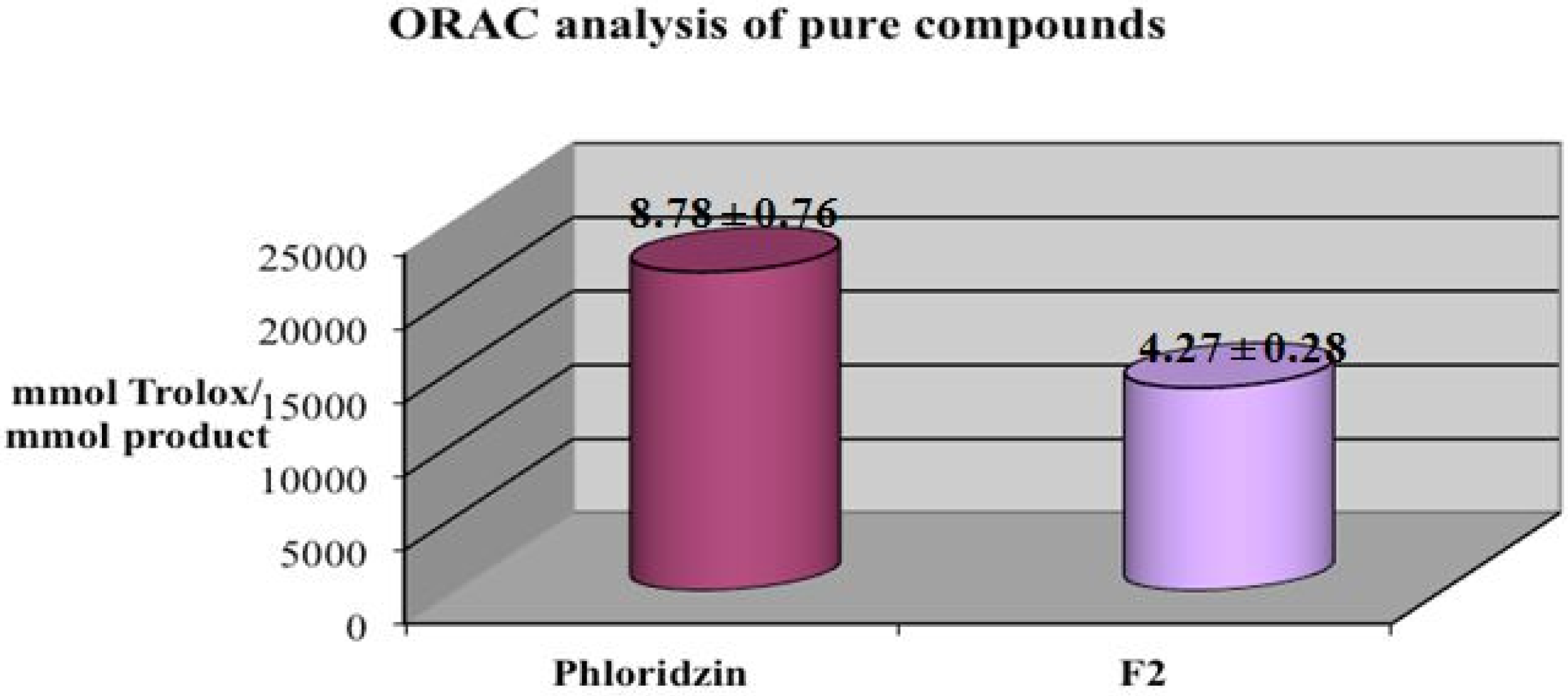Synthesis, Antioxidant and Antimicrobial Activity of a New Phloridzin Derivative for Dermo-Cosmetic Applications
Abstract
:1. Introduction
2. Results and Discussion
2.1. Chemistry

2.2. Stability Studies


| Octanol (mg/20 mL) | H2O (mg/20 mL) | LogP * | |
|---|---|---|---|
| Phloridzin | 4.48 | 0.52 | 0.94 |
| F2 | 4.925 | 0.075 | 1.82 |
2.3. Antioxidant Activity


2.4. Formulation Studies

2.5. Antufungal Acitivity
| Fungus | % Growth inhibition on the 7th days by phloridzin conc. (μg/mL) of | % Growth inhibition on the 7th days by F2 conc. (μg/mL) of | ||
|---|---|---|---|---|
| 20 | 100 | 20 | 100 | |
| Epidermophyton floccosum | + | + | + | + |
| Trichophyton rubrum | + | + | 4.1 ± 0.3 | 4.0 ± 0.7 |
| Trichophyton tonsurans | 13.1 ± 1.1 | 7.1 ± 0.9 | 3.1 ± 0.4 | 8.0 ± 1.5 |
| Trichophyton violaceum | 0.7 ± 0.1 | 5.1 ± 1.2 | 20.1 ± 1.8 | 18.1 ± 1.7 |
| Trichophyton mentagrophytes | + | + | 22 ± 0.9 | 18.1 ± 0.7 |
| Microsporum gypseum | 4.1 ± 0.5 | + | 13.0 ± 1.2 | 16.0 ± 0.3 |
| Nannizzia cajetani | + | + | 9.1 ± 0.5 | 16.0 ± 1 |
| Microsporum canis | + | 7 ± 0.8 | 24.0 ± 1.1 | 31.6 ± 1.4 |
| Nannizzia gypsea | 0 | + | 11.0 ± 0.6 | 20.1 ± 0.8 |
3. Experimental
3.1. General
3.2. Synthesis
3.2.1. Synthesis of phlorizin heptaproprionate (F1)
3.2.2. Synthesis of phlorizin tetraproprionate (F2)
3.3. Antioxidant Activity Assays
3.3.1. Photochemiluminescence (PCL) Method
3.3.2. Oxygen Radical Absorbance Capacity (ORAC) Assay
3.4. Stability Studies
3.4.1. Solution Preparation
3.4.2. Dermo-Cosmetic Formulations
3.4.3. HPLC Methods
3.4.4. Statistical Evaluations
3.5. Antifungal Activity
3.5.1. Microorganisms
3.5.2. Evaluation of Antifungal Activity
4. Conclusions
Acknowledgements
- Sample Availability: Samples of the compounds phloridzin, F1 and F2 are available from the authors.
References
- Whiting, G.C.; Coggins, R.A. Estimation of the monomeric phenolics from ciders. J. Sci. Food Agric. 1975, 26, 1833–1838. [Google Scholar] [CrossRef]
- Ridgway, T.; Tucker, G. Phloridzin derivatives; food additives/chemopreventative drugs of the future. Biochem. Soc. Trans. 1997, 25, 109. [Google Scholar]
- Petersen, C. Analyse des phloridzins. Ann. Acad. Sci. Fr. 1835, 15, 178. [Google Scholar]
- Ehrenkranz, J.R.L. Compositions containing botanical extracts rich in phlorizin and methods for using such compositions in blood glucose modification and to affect aging. WO2006078848, 2006. [Google Scholar]
- Ehrenkranz, J.R.; Lewis, N.G.; Kahn, C.R.; Roth, J. Phlorizin: A review. Diabetes Metab. Res. Rev. 2005, 21, 31–38. [Google Scholar] [CrossRef]
- Ridgway, T.; O’Reilly, J.; West, G.; Tucker, G.; Wiseman, H. Potent antioxidant properties of novel applederived flavonoids with commercial potential as food additives. Biochem. Soc. Trans. 1996, 24, 391. [Google Scholar]
- Ridgway, T.; O’Reilly, J.; West, G.; Tucker, G.; Wiseman, H. Antioxidant action of novel derivatives of the apple-derived flavonoid phloridzin compared to oestrogen: relevance to potential cardioprotective action. Biochem. Soc. Trans. 1997, 25, 106. [Google Scholar]
- Rezk, B.M.; Haenen, G.R.; van der Vijgh, W.J.; Bast, A. The antioxidant activity of phloretin: the disclosure of a new antioxidant pharmacophore in flavonoids. Biochem. Biophys. Res. Commun. 2002, 295, 9–13. [Google Scholar] [CrossRef]
- Puel, C.; Quintin, A.; Mathey, J.; Obled, C.; Davicco, M.J.; Lebecque, P.; Kati-Coulibaly, S.; Horcajada, M.N.; Coxam, V. Prevention of bone loss by phloridzin, an apple polyphenol, in ovariectomized rats under inflammation conditions. Calcif. Tissue Int. 2005, 77, 311–318. [Google Scholar] [CrossRef]
- Boccia, M.M.; Kopf, S.R.; Baratti, C.M. Phlorizin, a competitive inhibitor of glucose transport, facilitates memory storage in mice. Neurobiol. Learn. Mem. 1999, 71, 104–112. [Google Scholar] [CrossRef]
- Sukhorukov, V.L.; Kürschner, M.; Dilsky, S.; Lisec, T.; Wagner, B.; Schenk, W.A.; Benz, R.; Zimmermann, U. Phloretin-induced changes of lipophilic ion transport across the plasma membrane of mammalian cells. Biophys. J. 2001, 81, 1006–1013. [Google Scholar] [CrossRef]
- Valenta, C.; Cladera, J.; O’Shea, P.; Hadgraft, J. Effect of phloretin on the percutaneous absorption of lignocaine across human skin. J. Pharm. Sci. 2001, 90, 485–492. [Google Scholar] [CrossRef]
- Gaudout, D.; Megard, D.; Inisan, C.; Esteve, C.; Lejard, F. Phloridzin-rich phenolic fraction and use thereof as a cosmetic, dietary or nutraceutical agent. U.S. Patent 2006073223, 2006. [Google Scholar]
- Veeriah, S.; Kautenburger, T.; Habermann, N.; Sauer, J.; Dietrich, H.; Will, F.; Pool-Zobel, B.L. Apple flavonoids inhibit growth of HT29 human colon cancer cells and modulate expression of genes involved in the biotransformation of xenobiotics. Mol. Carcinog. 2006, 45, 164–174. [Google Scholar] [CrossRef]
- Gosch, C.; Stich, K.; Halbwirth, H. Cloning and heterologous expression of glycosyltransferases from Malus x domestica and Pyrus communis, which convert phloretin to phloretin 20-O-glucoside (phloridzin). Plant Sci. 2010, 178, 299–306. [Google Scholar] [CrossRef]
- Jugdé, H.; Nguy, D.; Moller, I.; Cooney, J.M.; Atkinson, R.G. Isolation and characterization of a novel glycosyltransferase that converts phloretin to phlorizin, a potent antioxidant in apple. FEBS J. 2008, 275, 3804–3814. [Google Scholar] [CrossRef]
- Gosch, C.; Halbwirth, H.; Kuhn, J.; Miosic, S.; Stich, K. Biosynthesis of phloridzin in apple (Malus domestica Borkh.). Plant Sci. 2009, 176, 223–231. [Google Scholar] [CrossRef]
- Cox, S.D.; Jayasinghe, K.C.; Markham, J.L. Antioxidant activity in Australian native sarsaparilla (Smilax glyciphylla). J. Ethnopharmacol 2005, 101, 162–168. [Google Scholar] [CrossRef]
- Dong, H.; Ning, Z.; Yu, L.; Li, L.; Lin, L.; Huang, J. Preparative separation and identification of the flavonoid phlorhizin from the crude extract of Lithocarpus polystachyus Rehd. Molecules 2007, 12, 552–562. [Google Scholar] [CrossRef]
- Hilt, P.; Schieber, A.; Yildirim, C.; Arnold, G.; Klaiber, I.; Conrad, J.; Beifuss, U.; Carle, R. Detection of phloridzin in strawberries (Fragaria x ananassa Duch.) by HPLC-PDA-MS/MS and NMR spectroscopy. J. Agric. Food. Chem. 2003, 51, 2896–2899. [Google Scholar] [CrossRef]
- Zhang, X.Z.; Zhao, Y.B.; Li, C.M.; Chen, D.M.; Wang, G.P.; Chang, R.F.; Shu, H.R. Potential polyphenol markers of phase change in apple (Malus domestica). J. Plant. Physiol. 2007, 164, 574–580. [Google Scholar] [CrossRef]
- MacDonald, R.E.; Bishop, C.J. Phloretin: An antibacterial substance obtained from apple leaves. Can. J. Bot. 1952, 30, 486–489. [Google Scholar] [CrossRef]
- Gessler, C.; Patocchi, A.; Sansavini, S.; Tartarini, S.; Gianfranceschi, L. Venturia inaequalis resistance in apple. Crit. Rev. Plant. Sci. 2006, 25, 473–503. [Google Scholar] [CrossRef]
- Doll, R.; Peto, R. The causes of cancer: Quantitative estimates of avoidable risks of cancer in the United States today. J. Natl. Cancer. Inst. 1981, 66, 1191–1308. [Google Scholar]
- Willett, W.C. Diet, nutrition, and avoidable cance. Environ. Health Perspect. 1995, 103, 165–170. [Google Scholar]
- Sesso, H.D.; Gaziano, J.M.; Liu, S.; Buring, J.E. Flavonoid intake and the risk of cardiovascular disease in women. Am. J. Clin. Nutr. 2003, 77, 1400–1408. [Google Scholar]
- Arts, I.C.W.; Jacobs, D.R.; Harnack, L.J.; Gross, M.; Folsom, A.R. Dietary catechins in relation to coronary heart disease death among postmenopausal women. Epidemiology 2001, 12, 668–675. [Google Scholar] [CrossRef]
- Hollman, P.C.H.; Katan, M.B. Absorption, metabolism and health effects of dietary flavonoids in man. Biomed. Pharmacother. 1997, 51, 305–310. [Google Scholar] [CrossRef]
- Liu, R.H. Health benefits of fruit and vegetables are from additive and synergistic combinations of phytochemicals. Am. J. Clin. Nutr. 2003, 78, 517S–520S. [Google Scholar]
- Aprikian, O.; Levrat-Verny, M.A.; Besson, C.; Busserolles, J.; Remesy, C.; Demigne, C. Apple favourably affects parameters of cholesterol metabolism and of anti-oxidative protection in cholesterol-fed rats. Food Chem. 2001, 75, 445–452. [Google Scholar] [CrossRef]
- Leontowicz, M.; Gorinstein, S.; Bartnikowska, E.; Leontowicz, H.; Kulasek, G.; Trakhtenberg, S. Sugar beet pulp and apple pomace dietary fibers improve lipid metabolism in rats fed cholesterol. Food Chem. 2001, 72, 73–78. [Google Scholar] [CrossRef]
- Gaudout, D.; Megard, D.; Inisan, C.; Esteve, C.; Lejard, F. Phloridzin-rich phenolic fraction and use thereof as a cosmetic, dietary or nutraceutical agent. U.S. Patent 2006/0073223 A1, 2006. [Google Scholar]
- Salles, B.; Provot, C.; Calsou, P.; Hennebelle, J.; Gosset, I.; Fournié, G.J. A chemiluminescent microplate assay to detect DNA damage induced by genotoxic treatments. Anal. Biochem. 1995, 232, 37–42. [Google Scholar]
- Hunter, M.D.; Hull, L.A. Variation in concentrations of phloridzin and phloretin in apple foliage. Phytochemistry 1993, 34, 1251–1254. [Google Scholar] [CrossRef]
- Vertuani, S.; Beghelli, E.; Scalambra, E.; Malisardi, G.; Copetti, S.; Dal Toso, R.; Baldisserotto, A.; Manfredini, S. Activity and stability studies of verbascoside, a novel antioxidant, in dermo-cosmetic and pharmaceutical topical formulations. Molecules 2011, 16, 7068–7080. [Google Scholar] [CrossRef]
- Ziosi, P.; Manfredini, S.; Vertuani, S.; Ruscetta, V.; Radice, M.; Sacchetti, G. Evaluating Essential Oils in Cosmetics: Antioxidant Capacity and Functionality. Cosmet. Toiletries 2010, 32–39. [Google Scholar]
- Lewin, G.; Popov, I. Oxidants and antioxidants part B—Antioxidative homeostasis: Characterization by means of chemiluminescent technique. Methods Enzymol. 1999, 300, 437–456. [Google Scholar]
- Popov, I.; Lewin, G. Photochemiluminescent detection of antiradical activity III: A simple assay of ascorbate in blood plasma. J. Biochem. Biophys. Methods 1994, 28, 277–282. [Google Scholar] [CrossRef]
- Pessina, F.; Marazova, K.; Ninfali, P.; Avanzi, L.; Manfredini, S.; Sgaragli, G. In vitro neuroprotection by novel antioxidants in guinea-pig urinary bladder subjected to anoxiaglucopenia/reperfusion damage. Naunyn Schmiedebergs Arch. Pharmacol. 2004, 6, 521–528. [Google Scholar]
© 2012 by the authors; licensee MDPI, Basel, Switzerland. This article is an open-access article distributed under the terms and conditions of the Creative Commons Attribution license (http://creativecommons.org/licenses/by/3.0/).
Share and Cite
Baldisserotto, A.; Malisardi, G.; Scalambra, E.; Andreotti, E.; Romagnoli, C.; Vicentini, C.B.; Manfredini, S.; Vertuani, S. Synthesis, Antioxidant and Antimicrobial Activity of a New Phloridzin Derivative for Dermo-Cosmetic Applications. Molecules 2012, 17, 13275-13289. https://doi.org/10.3390/molecules171113275
Baldisserotto A, Malisardi G, Scalambra E, Andreotti E, Romagnoli C, Vicentini CB, Manfredini S, Vertuani S. Synthesis, Antioxidant and Antimicrobial Activity of a New Phloridzin Derivative for Dermo-Cosmetic Applications. Molecules. 2012; 17(11):13275-13289. https://doi.org/10.3390/molecules171113275
Chicago/Turabian StyleBaldisserotto, Anna, Gemma Malisardi, Emanuela Scalambra, Elisa Andreotti, Carlo Romagnoli, Chiara Beatrice Vicentini, Stefano Manfredini, and Silvia Vertuani. 2012. "Synthesis, Antioxidant and Antimicrobial Activity of a New Phloridzin Derivative for Dermo-Cosmetic Applications" Molecules 17, no. 11: 13275-13289. https://doi.org/10.3390/molecules171113275
APA StyleBaldisserotto, A., Malisardi, G., Scalambra, E., Andreotti, E., Romagnoli, C., Vicentini, C. B., Manfredini, S., & Vertuani, S. (2012). Synthesis, Antioxidant and Antimicrobial Activity of a New Phloridzin Derivative for Dermo-Cosmetic Applications. Molecules, 17(11), 13275-13289. https://doi.org/10.3390/molecules171113275






